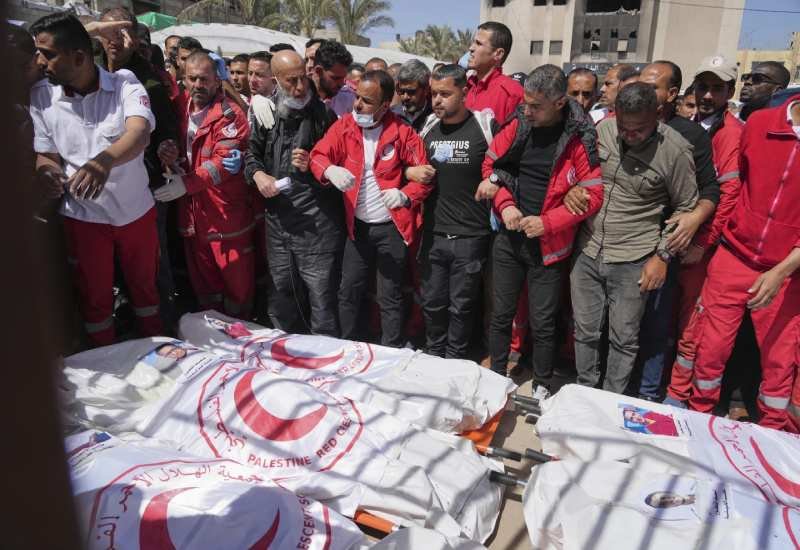- A newly released video contradicts Israeli claims about Palestinian medics’ deaths.
- The video shows medics with emergency lights on when Israeli forces fired at them.
- Israeli military’s initial account of the incident was proven inaccurate.
- 15 medics were killed by Israeli forces on March 23 in southern Gaza.
- One medic remains missing, raising concerns about his whereabouts.
A newly surfaced phone video contradicts Israeli claims about the deaths of 15 Palestinian medics in southern Gaza. The footage, taken on March 23, shows emergency vehicles with flashing lights.
These vehicles had visible logos, which challenges Israel’s statement that they had no emergency signals. The attack occurred during an Israeli military operation in Rafah’s Tel al-Sultan district. The video was found in a slain medic’s pocket.
The Incident: What Happened on March 23
On March 23, Red Crescent and Civil Defense vehicles entered Tel al-Sultan in southern Gaza early in the morning. They responded to an ambulance that had been attacked earlier.
Unfortunately, the medics, including eight Red Crescent workers, six Civil Defense members, and one UN staffer, were killed in the shooting.
Later, Israeli forces buried their bodies, along with their damaged vehicles, in a mass grave, delaying recovery efforts for a week.
However, the footage of the incident is now in the possession of the United Nations. Munzer Abed, one of the few survivors, verified the video, as he was part of the convoy that came under fire. He pointed out that the vehicles were clearly marked as emergency responders and their lights were flashing when they approached the scene.
Moreover, Abed confirmed that the medics did not act in a threatening manner, as the footage shows. He also recognized the concrete structures visible in the video. These structures matched the site where the bodies were eventually recovered, ensuring the video’s authenticity.
In the meantime, the Palestinian ambassador shared the video with the UN Security Council. The Associated Press later obtained a copy from a UN diplomat, under anonymity.
Initially, the Israeli military claimed that the vehicles lacked emergency signals and “advanced suspiciously” on nearby troops.
However, an Israeli official later admitted that the initial statement was wrong, confirming the emergency lights had indeed been on.
Survivor Accounts: Munzer Abed’s Testimony
Survivor Munzer Abed shared his traumatic experience after Israeli soldiers shot at his ambulance. He heard gunfire, and then the vehicle stopped. Soldiers dragged him out, beat him, and questioned his paramedic training.
Abed described the terror as soldiers forced him to strip and interrogated him. His testimony reveals the brutal attack, adding to claims that medics were intentionally targeted. Despite everything, he was eventually released.
A Harrowing Rescue Attempt: Medics Under Fire
A shocking video from a rescue convoy shows medics arriving at the site, only to face immediate gunfire. The shaky footage reveals the terror as they approach the ambulance, unsure of what’s coming.
At one point, a man shouts, “Lord, let them be OK.” Shortly after, gunfire erupts, and one medic is struck. The situation escalates quickly, filling the scene with fear and chaos.
The person recording the video repeatedly recites the Muslim profession of faith, clearly terrified for his life. After nearly six and a half minutes, the footage abruptly cuts off, with voices in Hebrew heard in the background.
Initially, Israel claimed the shooting was justified, saying the medics advanced “suspiciously” without emergency signals. However, they later admitted the vehicles did have their emergency lights flashing at the time of the incident.
The Israeli military stated they found a Hamas figure among the dead. However, there’s no evidence connecting the medics to Hamas. Jonathan Whittall from the UN dismissed this claim, confirming the medics were known to be humanitarian workers.
Calls for Independent Investigation
Younes Al-Khatib, head of the Palestinian Red Crescent Society, called for an independent investigation. He expressed distrust in the Israeli military’s internal review processes, believing them to be unreliable.
Al-Khatib emphasized that the medics were “targeted at close range.” He also expects forensic autopsy reports to provide more clarity on the cause of death, which remains unclear.
As one medic is still missing, calls for an impartial investigation grow stronger. With Israel’s claims under scrutiny, the brutal killing raises serious concerns about the safety of humanitarian workers in conflict zones.
A newly released video from March 23 paints a chilling picture. It contradicts Israeli military claims and raises important concerns about the treatment of emergency responders in conflict zones.


